UPSC Exam > UPSC Notes > Additional Study Material for UPSC > The Hindu Editorial Analysis- 14th December, 2020
The Hindu Editorial Analysis- 14th December, 2020 | Additional Study Material for UPSC PDF Download
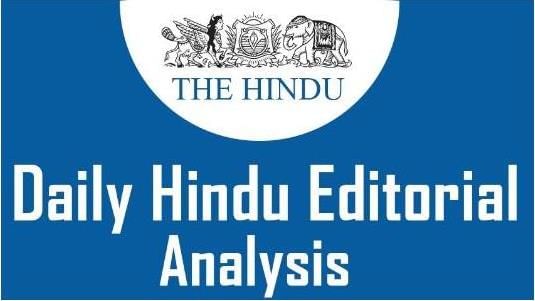
1. Dangerous Impasse-
GS 3- Security challenges and their management in border areas
Context
- The recent border skirmishes with China in the Galwan Valley took the lives of 20 Indian Soldiers. This was indeed the severe border conflict with China to have occurred after the 1962 war.
- The tenions with China continues, as the Winter sets in, after more than a month since the last round of talks between Corps Commanders to take forward disengagement on the Line of Actual Control (LAC).
- Looking forward, there seems to be no road map yet to a return to the status quo prior to May’s transgressions by China. Troops of both the nations fought at Pangong Tso in Ladakh on 5/6th May.
- External Affairs Minister S. Jaishankar acknowledged last week that the relaton between both the nations have brought ties to the “most difficult phase” in the last 30 to 40 years.
Line of Actual Control?
- The LAC is the demarcation that separates Indian-controlled territory from Chinese-controlled territory.
- India considers the LAC to be 3,488 km long, while the Chinese consider it to be only around 2,000 km.
- It is divided into three sectors: the eastern sector which spans Arunachal Pradesh and Sikkim, the middle sector in Uttarakhand and Himachal Pradesh, and the western sector in Ladakh.
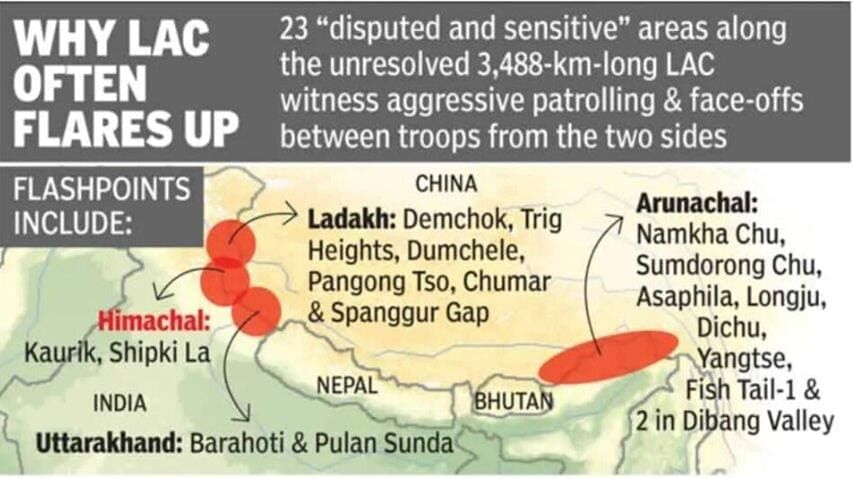
What is the Disagreement About?
- The alignment of the LAC in the eastern sector is along the 1914 McMahon Line, and there are minor disputes about the positions on the ground as per the principle of the high Himalayan watershed.
- This pertains to India’s international boundary as well, but for certain areas such as Longju and Asaphila.
- The line in the middle sector is the least controversial but for the precise alignment to be followed in the Barahoti plains.
India's Key Demand
India has sought the restoration of the status quo as it existed before the standoff began in May 2020. Troops of both the nations fought at Pangong Tso in Ladakh on 5/6th May.
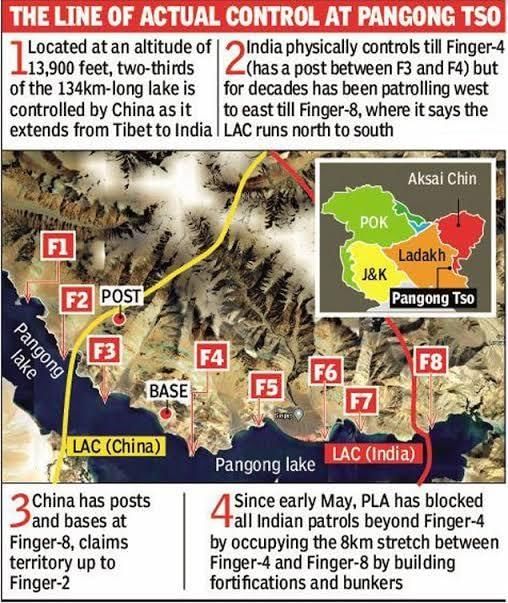
Reasons That Led to Increased China’s Deployment At the Lac
- One of the reasons is the decision of India to strengthen its border infrastructure (Darbuk-Shyok-Daulat Beg Oldie road).
- India being a part of QUAD and siding with the US to curb Chinese presence in the Inio-Pacific.
- Abrogation of A-370 and India claiming over the Gilgit-Baltistan is viewed by China as an implicit attack on the China-Pakistan Economic Corridor (CPEC), China’s flagship programme.
- China's ambition to be more dominant in the South China Sea and the Indian Ocean.
- Covid-19 pandemic has made the political and economic tensions within China grimmer.
Agreements On Border Between India and China
- Agreement on appointing Special Representatives (SRs) was signed in 2003. Later in 2005, there was agreement on the political parameters and principles that would underpin negotiations.
- The aim was a comprehensive solution encompassing all three sectors. The agreed boundary would follow well-defined geographical features and respect the interests of the settled populations.
- The proposal to clarify the LAC was rejected by the Chinese during PM Modi's visit to China in May 2015.
- In the Wuhan (2018) and Mahabalipuram (2019) summits, both China and India had reaffirmed that they will make efforts to “ensure peace and tranquility in the border areas”.
Current Situation
- While addressing a think-tank, Mr. Jaishankar said the relationship had been “profoundly disturbed” this summer, and China had “literally brought tens of thousands of soldiers in full military preparation mode right to the LAC in Ladakh”.
- China, in response to the Minister's statement yet again blamed India for the crisis, saying “the responsibility totally lies with the Indian side” and that it had strictly abided by border agreements.
- The sharp exchange underlined the perilous state of relations and the long road ahead towards restoring normalcy, which, India has made clear, is predicated on peace on the border.
- External Affairs Minister cautioned Indians that full disengagement may not be an immediate prospect, drawing a parallel to the Sumdorong Chu crisis of 1986 that took nine years to resolve.
- The slow-moving talks on the LAC raise questions about China’s willingness to both restore fully the status quo and abide by past agreements, which India must insist upon.
Conclusion
- The Indian government, for its part, should be far more forthcoming than it has been so far on the situation on the LAC.
- Peace on the border is what every other aspect of the relationship with China has rested on over the past three decades, from trade to growing links in new fields such as investment and education.
- Transparency, without which the public will not be fully aware about the border situation and the state of the broader relationship with China, should take precedence over optics and political expediency.
- Both the nations need to stick to the 2005 protocol and the 2013 Border Defence Cooperation Agreement.
2. Nursing Education - A sector That Needs to be Nursed Back to Health
GS 2– Education, Health, Govt. policies
Context
- Nursing education in India suffers poor quality of training, inequitable distribution, and non-standardised practices. There is a dire need to revive its way of functioning.
- The year 2020 has been designated as “International Year of the Nurse and the Midwife”.
- Nurses and midwives will be central to achieving universal health coverage in India.
About India’s Nursing System
- Nursing education in India has a wide array of certificate, diploma, and degree programmes for clinical and non-clinical nursing roles.
- India’s nursing workforce is about two-thirds of its health workforce.
- Its ratio of 1.7 nurses per 1,000 population is 43% less than the World Health Organisation norm; it needs 2.4 million nurses to meet the norm.
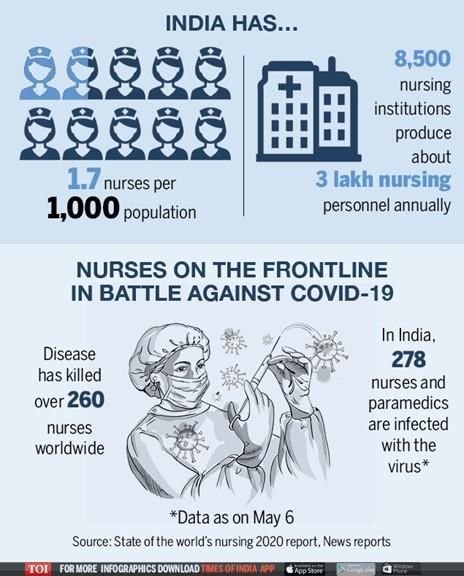
Universal Health Coverage
- Universal Health coverage means that all the individuals and communities should receive the benefit of health services without the burden of financial strain.
- It covers a range of services – promotion of health, prevention of diseases, rehabilitation, treatment, and palliative care.
- The purpose of the UHC is to bring patients under the ambit of these services who are facing serious illnesses that may cause death or even lead to bankruptcy in the event of all life savings being utilized to fight the disease. This will eventually help people to secure their future and often of their children.
- "Universal Health Coverage —Health for All: Protect Everyone", was the theme of 2020 which calls for strong measure for a strong health system in the face of the COVID crisis that would protect everyone.
Nursing Education Challenges
- In addition to the low number of nurses, the sector is dogged by structural challenges that lead to poor quality of training, inequitable distribution, and non-standardised practices.
➢ Uneven regulation
- The Indian Nursing Council regulates nursing education through prescription, inspection, examination, and certification.
- However, the induction requirements vary widely and so does the functioning of regulatory bodies in the States.
- In addition, 91% of the nursing education institutions are private and weakly regulated.
- The quality of training of nurses is diminished by the uneven and weak regulations.
➢ Outdated pedagogy
- The current nursing education is outdated and fails to cater to the practice needs - The education, including re-training, is not linked to the roles and their career progression in the nursing practice.
- There are insufficient postgraduate courses to develop skills in specialties, and address critical faculty shortages both in terms of quality and quantity.
- These factors have led to gaps in skills and competencies, with no clear career trajectory for nurses.
➢ Lack of uniformity in admission process
- Multiple entry points to the nursing courses and lack of integration of the diploma and degree courses diminish the quality of training.
- Uneven distribution of institutions: Although the institutions are increasing in number, around 62% of the institutes are situated in southern India.
➢ Less demand
- Despite the growth, there is little demand for postgraduate courses.
- Recognising the need for specialty courses in clinical nursing 12 post graduate diploma courses were rolled out but never did well due to lack of admissions, because the higher education qualification is not recognised by the recruiters.
- Further, the faculty positions vacant in nursing college and schools are around 86% and 80%, respectively.
➢ Gaps in education, services
- Most nurses working in the public and private health sector are diploma holders. There is a lack of job differentiation between diploma, graduate, and postgraduate nurses regarding their pay, parity, and promotion.
- Consequently, higher qualifications of postgraduate nurses are underutilised, leading to low demand for postgraduate courses.
- Advanced degree holders seek employment in education institutions or migrate abroad where their qualifications are recognised. This has led to an acute dearth of qualified nurses in the country.
- Small private institutions with less than 50 beds recruit candidates without formal nursing education. They are offered courses of three to six months for non-clinical ancillary nursing roles and are paid very little.
➢ Lack of guidelines
- The Indian Nursing Act primarily revolves around nursing education and does not provide any policy guidance about the roles and responsibilities of nurses in various cadres.
- Nurses in India have no guidelines on the scope of their practice and have no prescribed standards of care. This may endanger patient safety. It is a major reason for the low legitimacy of the nursing practice and the profession.
- Additionally, the mismatch of the role description and remuneration that befits the role sets the stage for the exploitation of nurses.
- The Consumer Protection Act which protects the rights and safety of patients as consumers, holds only the doctor and the hospital liable for medico-legal issues; nurses are out of the purview of the Act. This is contrary to the practices in developed countries where nurses are legally liable for errors in their work.
Way Forward
- The governance of nursing education and practice must be clarified and made current. The jurisdictions of the Indian Nursing Council and the State nursing councils must be explained and coordinated so that they are synergistic.
- The Indian Nursing Council Act of 1947 must be amended to explicitly state clear norms for service and patient care, fix the nurse to patient ratio, staffing norms and salaries.
- A common entrance exam, a national licence exit exam for entry into practice, and periodic renewal of licence linked with continuing nursing education would significantly streamline and strengthen nursing education.
- Transparent accreditation, benchmarking, and ranking of nursing institutions too would improve the quality.
- The exodus of qualified nurses must be contained i.e. the future path should be laid out for a clear direction for the fresh pass outs to move ahead.
- Incentives to pursue advanced degrees to match their qualification, opportunity for leadership roles, and improvements in the status of nursing as a profession will be key steps to do so.
- A live registry of nurses, positions, and opportunities should be a top priority to tackle the demand-supply gap in this sector.
- Public-private partnership between private nursing schools/colleges and public health facilities is another strategy to enhance nursing education.
What Has Been Done So Far?
- NITI Aayog has recently formulated a framework for public-private partnership in medical education that could be referred to develop a model agreement for nursing education.
- The Government has also announced supporting such projects through a Viability Gap Funding mechanism.
Niti Aayog
- The full form of NITI is National Institution for Transforming India”. NITI AAYOG is India’s advisory body and premier policy-making institution which seeks to catalyze the country’s holistic growth.
- It aims to transform India into a dynamic and strong nation which will eventually bolster India’s growth to become one of the greatest economies in the world.
A Bill That Could Spell Hope
A Bill That Could Spell Hope
- The disabling environment prevalent in the system has led to the low status of nurses in the hierarchy of health-care professionals.
- In fact, nursing has lost the appeal as a career option. Also, these disruptions are more relevant than ever in the face of the COVID-19 pandemic.
- The National Nursing and Midwifery Commission Bill currently under consideration should address some of the issues highlighted.
National Nursing And Midwifery Commission Bill
The National Nursing and Midwifery Commission Bill 2020 seeks to replace the existing Indian Nursing Council Act 1947.
- The new draft Bill replaces the Indian Nursing Council with a new body called National Nursing and Midwifery Commission.
- This body is supposed to consist of representatives at the Centre as well as at the state level.
- The bill is to regulate the standards for the working and governance of nursing and midwifery education and clinical facility in teaching institutions through new policies.
- It aims to provide basic standards of education, physical and instructional facilities, training, research, maximum tuition fee payable with respect to various categories.
- Keep a close eye on the professional ethics in nursing and midwifery profession.
➢ Other proposals
- A common entrance test for admissions to undergraduate nursing courses.
- A National Exit test for the final year of the nursing or midwifery course, to ensure uniform quality.
- Registration with the state boards mandatory for every nurse and midwife.
- The Bill will possibly allow the Board decide on the course structure, fee, etc.
- Maintain a national register to track all qualified and practising nursing professionals.
- Introduction of a temporary licence for foreign nationals who are qualified nurses and midwives for unhindered practice in India.
3. Hazardous Ideas for the Himalayas: China’s Hydropower Project in Tibet
GS 3- Conservation
Context
Recently a Chinese website reveals that china announced to build a major hydropower project on Yarlung Zangbo River in Tibet.
About China’s Project
- The website of the Central Committee of the Communist Youth League, reveals that China announced its planning to build a major hydropower project.
- The project will be as a part of its 14th Five-Year Plan (2021-25).
- It will be on the Yarlung Zangbo River, in Mêdog County in Tibet.
- Project’s electricity generation capacity will be 300 billion kWh annually.
- According to Chinese authorities, the project will help the country to realise its goal.
- The goal of China is to get carbon emission peak before 2030 and carbon neutrality before 2060.
- Tibet’s Medog county is near to India's state of Arunachal Pradesh, hence Indian counterparts were quick to reiterate their plan.
- As well as, India is reportedly thinking a 10-GW hydropower project in the state.
Current Situation
- Both India and China always try to ignore the harmful impacts of such dams on geology.
- So, they have to sit together to deliberate on the consequences of such a project in an area of massive earthquakes and landslides.
- From the past 20 years, both countries have been competing with each other to build hydroelectric dams in this area. The area is ecologically fragile and seismically vulnerable.
- On India’s side in the state of Arunachal Pradesh, there are two hydropower projects in the works on the tributaries of the Brahmaputra.
- One of the projects is the 600 MW Kameng project. This project is on the Bichom and Tenga Rivers.
- Another project is the 2,000 MW Subansiri Lower Hydroelectricity Project.
- On the other side, China has already completed 11 out of 55 projects in the Tibetan region.
- With these projects, both countries at a disturbing pace and overestimate their economic potential and extremely underestimate the earthquake vulnerability of the region.
Disasters in This Region
- In the 20th century, about 15% of the great earthquakes are with a magnitude of more than 8, occurred in the Himalayan region.
- In the last 100 years, the northeast Himalayan bend has experienced several large earthquakes of magnitude 7 and above.
- This number is more than the share from other parts of the Himalayas.
- In the year of 1950, an earthquake just south of the McMahon Line was of 8.6 magnitudes.
(a) This earthquake was the largest continental event ever recorded and it also destroys Tibet and Assam.
(b) In this earthquake thousands killed, and it also caused extensive landslides, widespread land level changes and gaping fissures.
(c) As well as, resulting in water and mud oozing.
(d) Later the dams were breached generating flash floods in the downstream sides, seriously silting the drainage systems.
(e) Impacted area of the earthquake was an extensive, comprising parts of India, Tibet, erstwhile East Pakistan and Myanmar.
(f) Hence if a similar event was to take place in the background of the fast-developing hydro projects, what will be the future of the Himalayas. - Before five years back in 2015, Gorkha earthquake of magnitude 7.8 in central Nepal resulted in huge losses in the hydropower sector.
(a) After this earthquake, Nepal lost about 20% of its hydropower capacity.
(b) As well as About 30 projects with a capacity of 270 MW, mostly located along the steep river valleys, were damaged.
(c) In the paper namely Geophysical Research Letters, there published a study by Wolfgang Schwanghart and others, is quite revelatory on the earthquake-borne damage sustained by hydropower projects in Nepal.
(d) The main reason that participates to the vulnerability of hydropower projects were found to be landslides.
Estimations For Future
- In the project sites and headwater region, it is expected to get heavy siltation from landslides from future earthquakes.
- This situation will severely reduce the water-holding capacity and life expectancy of such dams.
- Deforestation and road-building is another responsible reason for the slide.
- These activities will get intensified as part of the dam-building initiatives.
- So that the desilting of dams is not an economically viable proposition and is technologically challenging.
- From these perspectives, the northeast Himalayan bend is the most unsuitable locale within the Himalayas for giant dams.
About Himalayas
- It is a mountain range in Asia which separates the plains of the Indian subcontinent from the Tibetan Plateau.
- This range has many of Earth's highest peaks, including the Mount Everest.
- The Range include over fifty mountains with exceeding 7,200 m (23,600 ft) in elevation.
- Whereas ten of the fourteen with 8,000-metre peaks.
- The highest peak outside Asia is Aconcagua, in the Andes which is 6,961 m or22,838 ft tall.
- It is a transnational mountain chain.
- It spread across five countries: Bhutan, China, India, Nepal and Pakistan.
- This range is the chief driver of the Asian climate.
- The Himalayas range is a source for numerous Asian river systems and glaciers.
- Rivers systems and glaciers are now under the threat of degradation and retreat due to global warming.
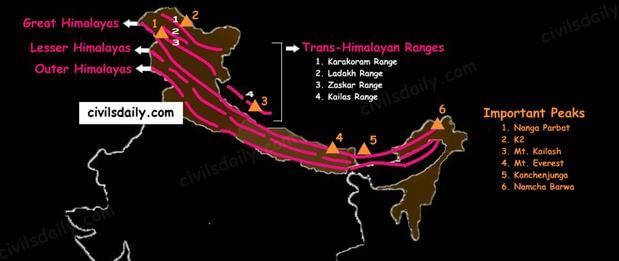
Conclusion
- Recently held low-level military dispute between these two countries have led to demands for further infrastructural development on both sides.
- In a recent article in Nature, the Himalayas have seen the highest rate of deforestation and land-use changes.
- The article suggests that the upper Himalayas should be converted into a nature reserve by an international agreement.
- The article also suggests the possibility of a Himalayan River Commission. The commission involving all the headwater and downstream countries needs to be explored.
- Both countries would be well advised to disengage from military adventurism.
- Carbon neutrality should not be at the cost of the environment.
The document The Hindu Editorial Analysis- 14th December, 2020 | Additional Study Material for UPSC is a part of the UPSC Course Additional Study Material for UPSC.
All you need of UPSC at this link: UPSC
|
21 videos|562 docs|160 tests
|
FAQs on The Hindu Editorial Analysis- 14th December, 2020 - Additional Study Material for UPSC
| 1. What is the dangerous impasse mentioned in the article? |  |
Ans. The dangerous impasse mentioned in the article refers to a situation of deadlock or stalemate that poses significant risks or dangers.
| 2. How is the nursing education sector in need of being nursed back to health? |  |
Ans. The nursing education sector is in need of being nursed back to health because it is currently facing various challenges such as outdated curriculum, lack of adequate infrastructure and resources, shortage of qualified faculty, and insufficient practical training opportunities.
| 3. What is the impact of China's hydropower project in Tibet on the Himalayas? |  |
Ans. China's hydropower project in Tibet has hazardous implications for the Himalayas. It could lead to ecological damage, displacement of local communities, alteration of river flows, and potentially exacerbate the risks of natural disasters such as floods and landslides.
| 4. What is the significance of the date mentioned in the article (14th December, 2020)? |  |
Ans. The date mentioned in the article (14th December, 2020) signifies the day on which the analysis or discussion took place. It helps provide a timeframe for the information and allows readers to understand the relevance and timeliness of the article's content.
| 5. What are some frequently asked questions related to UPSC exams? |  |
Ans. Some frequently asked questions related to UPSC exams include:
- What is the eligibility criteria for appearing in the UPSC exam?
- What is the exam pattern and syllabus for UPSC exams?
- How many attempts can one take for the UPSC exam?
- What is the age limit for UPSC exams?
- What is the selection process for UPSC exams?
Related Searches
















